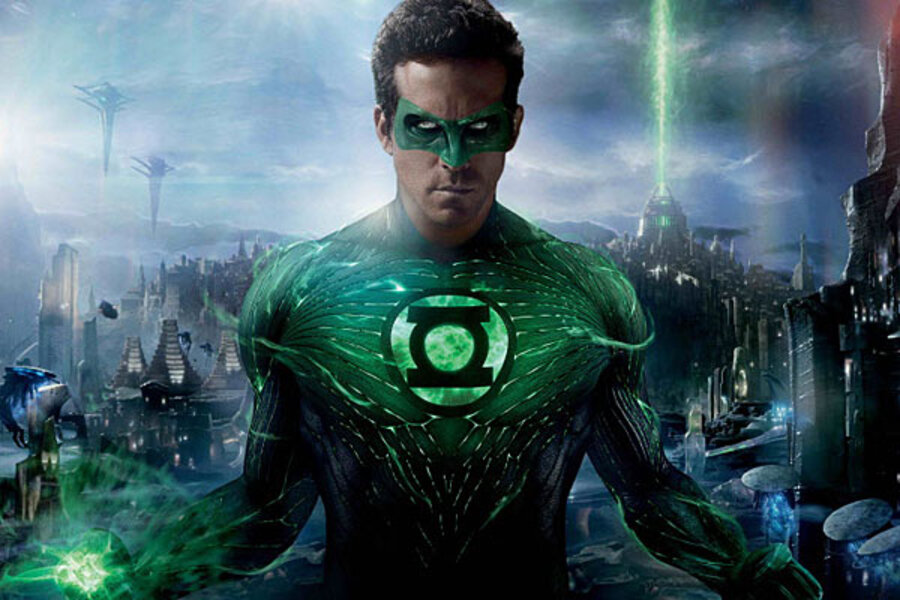'Green Lantern' is opening. Does it appeal only to white American males?
Loading...
| Los Angeles
When “Green Lantern” – the latest in this summer’s heavy slate of super-hero films – opens this weekend, fans of the lesser-known but iconic DC action figure are eager to see if he will catch on.
But, as movies continue to mine classic comic books, some critics suggest they are going retro in more ways than one, returning to the genre’s early weak spots: a lack of diversity and an overwhelming emphasis on white American male power fantasies.
“Hollywood often continues to use a white American male as its default lead character and assumes that viewers of all demographics will be able to identify with him,” says Amy Corbin, assistant professor of art and film studies at Muhlenberg College in Allentown, Penn.
The white male becomes the “universal” character who is supposedly compelling for everyone – while when women and people of color play the leads, those films are often assumed to be “niche” films that will only attract a viewing demographic that matches the lead character,” she adds via email.
The Green Lantern origin myth pushes this particular bias further than most in the super hero canon, says comic book expert Julian Chambliss, who teaches history at Rollins College in Winter Park, Florida. In the Green Lantern mythology, the latest wearer of the ring of power is chosen by the ring itself, specifically for the wearer’s strength of will and ability to overcome fear.
The ring is looking for “the best of the best,” says Mr. Chambliss, adding: “You’re telling me that in 2011, on a planet of some 7 billion people, the vast majority of whom are minority faces, that the best of the best is going to be a white guy from southern California?”
Dreams of a new franchise
This sends a troubling message, he says adding “there are many other figures they could have chosen to make a movie about, but this one is appealing much more strongly to the privileging of white, male American power than many others.”
Clearly, the studio hopes to launch a franchise, says Hollywood.com box office expert Paul Dergarabedian, adding “some of the other DC franchises like Batman and Superman are pretty long in the tooth, so they are hoping to find a new, long-lived action hero.”
To do so the studio sought a figure with wide appeal, particularly to the under-30 crowd, casting Ryan Reynolds as the lead. But, Mr. Dergarabedian adds, the phenomenal overseas success this summer of films such as “Fast Five” and “Pirates of the Caribbean: On Stranger Tides,” which has pulled in a record nearly $700 million foreign box office in its first month, suggests that a more diverse cast “would be a good idea.”
The legacy of the comic books themselves is partly to blame, says Jacque Nodell, granddaughter of Marty Nodell, the artist who created the first Green Lantern character in 1940.
“He was the child of a Ukrainian Jewish immigrant who knew well the sting of anti-Semitism,” she says, noting that the first version of the hero was blond. “My father was a little harsh about his own dad, but he summed it up when he said that his dad did what he needed to do to put bread on the table,” she says, adding that if that meant selling a fair-haired ideal of middle-American male power, then “so be it.”
Comic book universe expanded
However, the comic book universe has vastly expanded since its early days in World War II and Cold War America, points out Michael San Giacomo, who teaches a course in comic book history at Case Western Reserve University in Cleveland, Ohio.
“Before the sixties, comic books were largely aimed at young, white middle-American boys who had the disposable income to spend,” he says, adding, “but that began to change in the ‘60s and ‘70s, and they began adding black and Hispanic and female characters.”
Today, he says, the comic book universe if full of strong, diverse characters. The film spinoffs have not been as progressive. Still, there been tiny spots of progress, such as casting Samuel L. Jackson as Nick Fury, previously a white character, in “Iron Man.”
Falling back on cultural stereotypes has a long tradition, notes pop culture pundit Robert Thompson, a Syracuse University media professor. The image of the white he-man endowed with superpowers dates to some of our earliest Western stories, he says, adding “just look at them all from Hercules to Achilles to Jason.”
There is a certain irony in the emphasis on white, male power in the film, points out pop culture expert Rob Weiner, a humanities librarian at Texas Tech University. The larger Green Lantern universe does embrace a galaxy of aliens and multi-species cast of characters, “so if you are looking for real diversity it is actually there.”
“Maybe they’ll get to that in the sequel,” he says.





